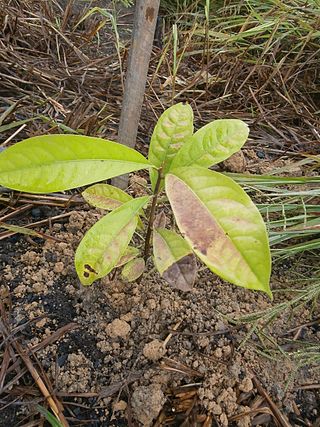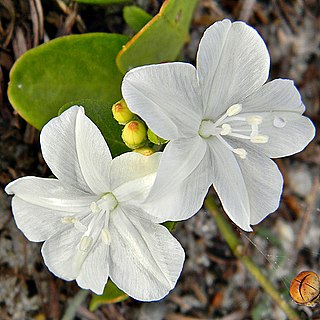
Nathaniel Lord Britton was an American botanist and taxonomist who co-founded the New York Botanical Garden in the Bronx, New York.

Cyphomandra was a formerly accepted genus in the plant family Solanaceae. It used to contain about 35 species native to the Americas from Mexico southwards to Northern Argentina.

Erythroxylum (Erythroxylon) is a genus of tropical flowering plants in the family Erythroxylaceae. Many of the approximately 200 species contain the substance cocaine, and two of the species within this genus, Erythroxylum coca and Erythroxylum novogranatense, both native to South America, are the main commercial source of cocaine and of the mild stimulant coca tea. Another species, Erythroxylum vaccinifolium is used as an aphrodisiac in Brazilian drinks and herbal medicine.

Echinodorus, commonly known as burhead or Amazon sword, is a genus of plants in the family Alismataceae, native to the Western Hemisphere from the central United States to Argentina. Its scientific name is derived from Ancient Greek echius – "rough husk" - and doros – "leathern bottle" - alluding to ovaries, which in some species are armed with persistent styles, forming prickly head of fruit. Some of the species are commonly cultivated in artificial aquatic habitats.

Lepechinia is a genus of plants in the mint family, Lamiaceae. It includes several species of plants known commonly as pitchersages. Plants of this genus can be found in Central and South America, Mexico, California, Hispaniola, and Hawaii, although the species in Hawaii is probably a human introduction. Many of them bear attractive pitcher-shaped flowers, often in shades of purple. The genus was named for the Russian botanist Ivan Ivanovich Lepechin. Recently, the two monotypic genera Chaunostoma and Neoeplingia were shown to be part of Lepechinia.
- Lepechinia anomalaEpling - southern Brazil
- Lepechinia bellaEpling - Bolivia
- Lepechinia betonicaefolia(Lam.) Epling - Colombia, Ecuador
- Lepechinia bullata (Kunth) Epling - Colombia, Ecuador, Venezuela
- Lepechinia calycina(Benth.) Epling ex Munz – pitcher sage, woodbalm - California
- Lepechinia cardiophyllaEpling – Santa Ana pitcher sage - southern California, Baja California
- Lepechinia caulescens(Ortega) Epling - Mexico, Guatemala
- Lepechinia chamaedryoides(Balb.) Epling - Chile
- Lepechinia cocuyensisJ.R.I.Wood - Colombia
- Lepechinia codonEpling - Peru
- Lepechinia conferta(Benth.) Epling - Colombia, Venezuela
- Lepechinia dioicaJ.A.Hart - Ecuador
- Lepechinia flammeaMart.Gord. & Lozada-Pérez - Guerrero
- Lepechinia floribunda(Benth.) Epling - Peru, Bolivia, Argentina
- Lepechinia fragrans(Greene) Epling – island pitcher sage, fragrant pitcher sage - southern California including offshore Channel Islands
- Lepechinia ganderiEpling – San Diego pitcher sage - southern California, Baja California
- Lepechinia glomerataEpling - Jalisco
- Lepechinia hastata(A.Gray) Epling – pakata - Baja California and Baja California Sur, including Revillagigedo Islands; naturalized in Hawaii
- Lepechinia heteromorpha (Briq.) Epling - Ecuador, Peru, Bolivia
- Lepechinia lamiifolia(Benth.) Epling - Ecuador, Peru
- Lepechinia lancifolia(Rusby) Epling - Bolivia
- Lepechinia leucophylloides(Ramamoorthy, Hiriart & Medrano) B.T.Drew, Cacho & Sytsma - Hidalgo
- Lepechinia maricaEpling & Mathias - Peru
- Lepechinia mecistandra(Donn.Sm.) H.K.Moon - Chiapas, Guatemala, El Salvador
- Lepechinia mexicana(S.Schauer) Epling - central + northeastern Mexico
- Lepechinia meyenii(Walp.) Epling - Peru, Bolivia, Argentina
- Lepechinia mollis(Epling) Epling - Peru
- Lepechinia mutica(Benth.) Epling - Ecuador
- Lepechinia nelsonii(Fernald) Epling - central + southern Mexico
- Lepechinia paniculata(Kunth) Epling - Ecuador
- Lepechinia radula (Benth.) Epling - Ecuador, Peru
- Lepechinia rossiiS.Boyd & Mistretta – Ross' pitcher sage - southern California
- Lepechinia rufocampiiEpling & Mathias - Ecuador
- Lepechinia salviae(Lindl.) Epling - Chile
- Lepechinia salviifolia(Kunth) Epling - Colombia, Venezuela
- Lepechinia schiedeana(Schltdl.) Vatke - Mexico, Guatemala, Costa Rica, Panama, Colombia, Venezuela
- Lepechinia scobinaEpling - Peru
- Lepechinia speciosa(A.St.-Hil. ex Benth.) Epling - southern Brazil
- Lepechinia tomentosa(Benth.) Epling - Peru
- Lepechinia urbani (Briq.) Epling - Hispaniola
- Lepechinia velutinaJ.R.I.Wood - Colombia
- Lepechinia vesiculosa(Benth.) Epling - Peru, Bolivia, Argentina
- Lepechinia vulcanicolaJ.R.I.Wood - Colombia
- Lepechinia yecoranaHenrickson, Fishbein & T.Van Devender - Sonora

Munnozia is a genus of flowering plants in the family Asteraceae. It is centered in the Andes.

Aegiphila is a genus of flowering plants in the mint family, Lamiaceae, first described in 1763. It was formerly classified in the Verbenaceae. It is native to Mexico, Central America, South America, the West Indies, and Florida.

Aniba is an American neotropical flowering plant genus in the family Lauraceae. They are present in low and mountain cloud forest in Caribbean islands, Central America, and northern to central South America.

Nautilocalyx is a genus of plants in the family Gesneriaceae. Its native range stretches from Costa Rica to southern Tropical America and to Trinidad. It is also found in Bolivia, Brazil, Colombia, Costa Rica, Ecuador, French Guiana, Guyana, Panamá, Peru, Suriname, Trinidad-Tobago and Venezuela.

Tetracera is a genus of flowering plants of the Dilleniaceae family native to the tropics. Several species are lianas.

Luehea is a genus of trees in the family Malvaceae.
Henry Hurd Rusby (1855–1940) was an American botanist, pharmacist and explorer. He discovered several new species of plants and played a significant role in founding the New York Botanical Garden and developing research and exploration programs at the institution. He helped to establish the field of economic botany, and left a collection of research and published works in botany and pharmacology.

Helanthium is a genus of plants in the Alismataceae, native to the Western Hemisphere. At present, three species are recognized:

Jacquemontia is a genus of plants in the morning glory family Convolvulaceae. Species in this genus are commonly known as clustervine.

Posoqueria is a genus of flowering plants in the family Rubiaceae. The genus is found Mexico to tropical America.
Clavija is a genus of flowering plants belonging to the family Primulaceae.
Maripa is a genus of flowering plants belonging to the family Convolvulaceae.
Onychopetalum is a genus of flowering plants belonging to the family Annonaceae.
Leptobalanus is a genus of flowering plants belonging to the family Chrysobalanaceae.
Passovia is a genus of flowering plants belonging to the family Loranthaceae.













